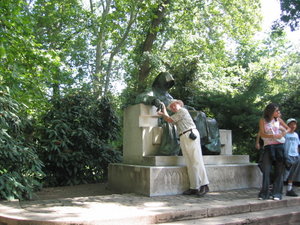Advertisement
Published: April 10th 2010

 ANONYMOUS
ANONYMOUS
Tom rubbing his pen not knowing its too late for him.Sunday morning and Budapest sleeps. Mostly. Elysee and I are up and on our way for a guided four-hour walking tour of the city. Across one bridge and then another, up one hill and down again. But what better time to see a city than early on a Sunday morning, when all the nighttime revelers are still asleep and even the gypsies are too tired to bother you. I highly recommend these walking tours found in most major cities as an alternative to the standard commercial “City Tours”; on and off the bus, seven languages and please buy my cousin’s postcards.
BUDAPEST A CITY OF BATHS. Many European cities boast about their famous baths and spas, popular as a health treatment especially during the later stages of the Belle Epoch; but none have taken it to the limits of Budapest since ancient Roman times. Budapest is blessed with over a hundred thermal springs that are very hot, and over 400 mineral springs. Thus the baths are supplied from natural resources. Besides the well-known Gellert baths, situated inside the turn-of-the-century Gellert Hotel, there are public baths throughout the city, none more representative than Szechenyi Bath, which is the largest mineral bath
in Europe. We entered these baths through the “needy” gate, which was queued up with people who had publicly paid prescriptions from their doctor ordering the “cure” as vital for their continued survival.
FREDOM SQUARE. We made the essential visit to Freedom Square, extolling ancient and modern Hungarian heroes, (of which there are a great number because Hungary was occupied by almost everyone, Mongols, Turks, Austrians, Russians, and fighting for their freedom for a thousand years or more resulted in a lot of Hungarian heroes).
BUDAPEST SYNAGOGUE. Also important was viewing the “Great Synagogue,” which is the largest in Europe and the second largest in the world outside of New York City’s. It is a stunning building completed after five years in 1859, combining Moorish and Romantic period elements. During the holocaust more than 400,000 Hungarian Jews were murdered by the Nazi regime.
CHAIN BRIDGE.Another highlight of the tour was a walk across the Chain Bridge that was designed by a Scotsman, Clark Adam and also opened in 1859. It was a marvel of its age, combining steel cabling and concrete and resembling and serving as precedent for the much larger Brooklyn Bridge about 40 years later.

 SZECHENYI BATHS
SZECHENYI BATHS
ON A SUNDAY MORNING IN JULYThe bridge created the first link of Buda and Pest, yet another generation passed before the cities were united. Politics got in the way, with the nobility on the Buda side refusing to be associated (and taxed) with the peasantry on the Pest side.
ANONYMOUS. A final highlight of the tour was discovering the actual location of that most famous person every college student gets to quote over and over again in their term papers, Anonymous; Ey-noni-moose. Hey! He (She?) really existed! In the City Park is a hooded statue (of course you can’t see the face of Anonymous) of an unknown scribe who, during the reign of King Bela III wrote a history of the early Maygars. The scribes pen is a touchstone for all Hungarian students before they take their college examinations, as well as aspiring writers seeking inspiration.
Arriving back at our hotel we found that our friends and neighbors the Love's had arrived. Together we saw more of Budapest before leaving for Bled where they were to spend several more days at our "love nest."
Advertisement
Tot: 0.339s; Tpl: 0.013s; cc: 15; qc: 46; dbt: 0.0601s; 1; m:domysql w:travelblog (10.17.0.13); sld: 1;
; mem: 1.1mb

 ANONYMOUS
ANONYMOUS
 MAGNIFICENT BUDAPEST SYNAGOGUE
MAGNIFICENT BUDAPEST SYNAGOGUE
 SZECHENYI BATHS
SZECHENYI BATHS